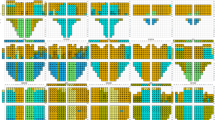Abstract
Only very few of the existing container loading algorithms include in their logic any references to the weight or the load bearing abilities of the items to be stowed. The paper aims to make a contribution to overcoming this shortcoming. It shows how a procedure which has already been evaluated in some detail in the literature can be adapted in a fairly straightforward manner to deal with fragility considerations. The approach suggested is based on opportunity cost notions. It is demonstrated that the results obtained can be vastly superior to a procedure which considers load bearing ability merely in terms of a constraint on the packing options available at each stage. Additional refinements of the basic approach and questions related to its practical implementation are also discussed, as are possible extensions to enable ‘soft’ positioning rules to be incorporated.
Zusammenfassung
Nur sehr wenige Containerbeladungs-Algorithmen nehmen in ihrer Logik Bezug auf das Gewicht oder die Tragfähigkeit der zu verladenden Güter. Der Artikel versucht, einen Beitrag zur Überwindung dieses Mangels zu leisten. Es wird gezeigt, wie ein Verfahren, das bereits zu einem gewissen Grad in der Literatur behandelt wurde, auf relativ einfache Weise adaptiert werden kann, um die Einbeziehung von Belastbarkeitsüberlegungen zu ermöglichen. Die vorgestellte Methode beruht auf Opportunitätskostenprinzipien. Es wird demonstriert, daß die Ergebnisse beträchtlich besser sein können als die, die man erhält wenn Tragfähigkeit nur als Restriktion bezüglich der im jeweiligen Algorithmusschritt zulässigen Alternativen behandelt wird. Zusätzliche Verfeinerungen der Methodik und Fragen hinsichtlich des praktischen Einsatzes werden ebenfalls diskutiert. Zudem werden potentielle Erweiterungen erörtert, die es ermöglichen, ‚weiche‘ Plazierungsregeln in das Verfahren einzubeziehen.
Similar content being viewed by others
References
Bischoff EE, Janetz F, Ratcliff MSW (1995) Loading pallets with non-identical items. EJOR 84: 681–692
Bischoff EE, Ratcliff MSW (1995) Loading multiple pallets. JORS 46: 1322–1336
Bischoff EE, Ratcliff MSW (1995) Issues in the development of approaches to container loading. Omega 23/4: 337–390
Dyckhoff H (1990) A typology of cutting and packing problems. EJOR 44: 145–159
Gehring H, Menschner K, Meyer M (1990) A computer-based heuristic for packing pooled shipment containers. EJOR 44: 277–288
Lin J-L, Foote B, Pulat S, Chang C-H, Cheung JY (1993) Hybrid genetic algorithm for container packing in three dimensions. Proceedings of the 9th Conference on AI Applications, Orlando, IEEE, pp 353–359
Liu NC, Chen LC (1981) A new algorithm for container loading. Compsac 81 — 5th International Computer Software and Applications Conference Proceedings, Chicago, IEEE, pp 292–299
Ratcliff MSW (1996) Aspects of container loading. Unpublished Ph. D. Thesis, University of Wales, Swansea
Author information
Authors and Affiliations
Rights and permissions
About this article
Cite this article
Ratcliff, M.S.W., Bischoff, E.E. Allowing for weight considerations in container loading. OR Spektrum 20, 65–71 (1998). https://doi.org/10.1007/BF01545534
Received:
Accepted:
Issue Date:
DOI: https://doi.org/10.1007/BF01545534




